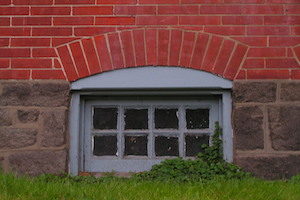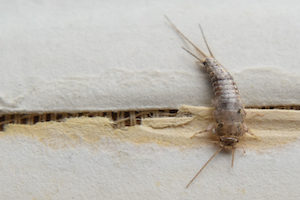Spiders are mysterious creatures. How do they know how to build those webs so perfectly? Why do they have so many legs? Most importantly, where are they coming from and how can you get rid of them? This time of year, you may have noticed that your leggy pals don’t seem to be around as much.
First, you probably felt relieved… then, you started to feel suspicious. Where’d they go? What are they planning?! We can’t promise to make you feel better, but we can provide you with an answer. Different spider species cope with winter in all kinds of different ways. If you can’t find your spiders this winter (and you want to, for some reason), here’s where they’ve probably gone.
Nests During the Winter
 Spider eggs can’t survive freezing temperatures, so spiders that want their eggs to survive winter have to get creative. Many spider species mate and produce their eggs starting in early fall. As temperatures begin to fall, many spider moms begin carefully choosing the places they lay their eggs. Spiders prefer to lay eggs in hidden, dark, and secluded locations like chimneys, downspouts, or burrows. These sheltered areas keep the eggs warm and alive until spring.
Spider eggs can’t survive freezing temperatures, so spiders that want their eggs to survive winter have to get creative. Many spider species mate and produce their eggs starting in early fall. As temperatures begin to fall, many spider moms begin carefully choosing the places they lay their eggs. Spiders prefer to lay eggs in hidden, dark, and secluded locations like chimneys, downspouts, or burrows. These sheltered areas keep the eggs warm and alive until spring.
In many cases, spiders construct special, nest-like webs where they lay their eggs. Usually, these webs incorporate sheltered surroundings. A spider might create a wall of webbing to cover an exposed corner or fill in a crack. Young spiders inside the nest eat their way out as soon as it’s warm enough to survive exposure. Many of the spiders that build nests for their young die after they finish. Now that’s motherly love!
Insulation from the Cold
 If it wasn’t obvious already, spiders are quite resourceful! Some spiders survive winter by building themselves a cozy little pod to hunker down in until things warm up. These pods are quite similar to spider egg nests. The spider finds an enclosed, secluded area, and seals themselves within the space by covering openings with their webbing. The webbing blocks cold air, hopefully creating an environment that’s warm enough for the spider to survive in.
If it wasn’t obvious already, spiders are quite resourceful! Some spiders survive winter by building themselves a cozy little pod to hunker down in until things warm up. These pods are quite similar to spider egg nests. The spider finds an enclosed, secluded area, and seals themselves within the space by covering openings with their webbing. The webbing blocks cold air, hopefully creating an environment that’s warm enough for the spider to survive in.
Some spiders build their sacs near the ground and let snow build up over them for an added insulating layer. Others build onto the high corners of roofing or siding on buildings. If you look closely, you might see small webbing sacs affixed to the sides of sturdier shelters in winter. On warm days, spiders break through their web sacs in order to hunt for food. When temperatures cool again, they’ll return to their sac and re-seal it.
Spiders Natural Antifreeze
 Spider species native to cold climates have been developing adaptations to freezing temperatures for centuries. When these spiders sense dropping temperatures, they begin accumulating glycol compounds in their bloodstream. These compounds function very similarly to the antifreeze commonly used in car engines. They allow the spider’s tissues to “supercool” and remain unfrozen even when exposed to below-freezing temperatures. While this trick keeps the spiders from freezing completely, it won’t save them forever on its own.
Spider species native to cold climates have been developing adaptations to freezing temperatures for centuries. When these spiders sense dropping temperatures, they begin accumulating glycol compounds in their bloodstream. These compounds function very similarly to the antifreeze commonly used in car engines. They allow the spider’s tissues to “supercool” and remain unfrozen even when exposed to below-freezing temperatures. While this trick keeps the spiders from freezing completely, it won’t save them forever on its own.
After building up glycol compounds, the spider seeks out a shelter where they can hide for the winter. Many antifreeze-producing spiders work their way through the top layer of snow and soil, reaching the “subnivean zone”. The subnivean zone insulates the spider from the worst cold while letting them move around and even hunt prey. Spiders stop producing their biological antifreeze when the air temperature begins rising again in spring.
Spiders in Your Home During the Winter
 Without the ability to survive freezing temperatures, spiders need shelter to make it through winter. What better shelter could there be than your home? After all, it works for you! Like many pests, some spider aggressively attempt to enter enclosed shelters in fall and winter.
Without the ability to survive freezing temperatures, spiders need shelter to make it through winter. What better shelter could there be than your home? After all, it works for you! Like many pests, some spider aggressively attempt to enter enclosed shelters in fall and winter.
When spiders choose where to overwinter, they’re looking for a warm, humid place where they can build a web in peace. If your home provides them with a place like this, they’ll be all over it. Spiders are excellent climbers, so they often infiltrate homes by climbing through gaps in windows, siding, or roof shingles. Attics, basements, closets, and dark pantries are all favored spider haunts. They also like any place where they can continue catching prey. If you have other pest problems this winter, spiders will come looking to capitalize on them.
As you can see, there’s no need to feel sorry for spiders that get locked out this season. Something tells us they’re going to be just fine. Maybe it’s the fact that they can make antifreeze in their bodies!
If you don’t have to feel sorry for spiders outside, then you really don’t have to worry about kicking spiders out of your home! If you have a couple of problems with eight legs, give Griffin a call anytime. We’ll make sure your spiders use all eight of those legs to step out of your life.



 Drafts happen when a gap in the wall of a home allows cold air to seep in. That cold air replaces warm air in the home by sucking it out the same gap where it got in. Pests feel this hot air from outside and follow it, hoping to find a place to keep warm. Mice are particularly good at finding and following drafts. Just about any gap wide enough to create a draft could be wide enough to
Drafts happen when a gap in the wall of a home allows cold air to seep in. That cold air replaces warm air in the home by sucking it out the same gap where it got in. Pests feel this hot air from outside and follow it, hoping to find a place to keep warm. Mice are particularly good at finding and following drafts. Just about any gap wide enough to create a draft could be wide enough to  All living creatures need water to live, even overwintering pests. Moisture and humidity attracts pests almost as much as the promise of warmth. Little insects don’t require much water to get by, so even a small plumbing leak works just fine. Pests find the moisture they need by sensing air humidity or smelling loose moisture. Even small plumbing leaks can drive up a home’s humidity enough to attract pests.
All living creatures need water to live, even overwintering pests. Moisture and humidity attracts pests almost as much as the promise of warmth. Little insects don’t require much water to get by, so even a small plumbing leak works just fine. Pests find the moisture they need by sensing air humidity or smelling loose moisture. Even small plumbing leaks can drive up a home’s humidity enough to attract pests.  Food attracts pests just as reliably in winter as it does the rest of the year. Cereals, bread, and other grains are
Food attracts pests just as reliably in winter as it does the rest of the year. Cereals, bread, and other grains are  We started talking about this during the draft section, but it bears repeating. Entryways like doors and windows are the number one way pests get into homes. Tiny gaps naturally develop near doors and windows in several ways. The elements wear away at thresholds and weatherstripping. Continual use may warp or damage joints, housing, or moving parts. Some pests even work away at sealing surrounding thresholds themselves.
We started talking about this during the draft section, but it bears repeating. Entryways like doors and windows are the number one way pests get into homes. Tiny gaps naturally develop near doors and windows in several ways. The elements wear away at thresholds and weatherstripping. Continual use may warp or damage joints, housing, or moving parts. Some pests even work away at sealing surrounding thresholds themselves. 
 We’ll grant you:
We’ll grant you:  Silverfish are those tiny, silver-grey insects that really look more like shrimp than fish or bugs. Their long, thin bodies wiggle back and forth when they crawl, making it look like they’re swimming. “Silver” because of the color. “Fish” because of what they look like. Like earwigs, silverfish love moisture. They’re also attracted to warm and dark places where they can move around without being bothered. Silverfish are nocturnal, so chances are you’ll only see them at night.
Silverfish are those tiny, silver-grey insects that really look more like shrimp than fish or bugs. Their long, thin bodies wiggle back and forth when they crawl, making it look like they’re swimming. “Silver” because of the color. “Fish” because of what they look like. Like earwigs, silverfish love moisture. They’re also attracted to warm and dark places where they can move around without being bothered. Silverfish are nocturnal, so chances are you’ll only see them at night. Pillbugs are very small, black bugs that are about as wide as they are long. Their backs are made up of seven overlapping, segmented plates that look hard and shiny, like a beetle’s shell. Pillbugs roll into a ball to protect themselves when threatened. These “bugs” (they’re
Pillbugs are very small, black bugs that are about as wide as they are long. Their backs are made up of seven overlapping, segmented plates that look hard and shiny, like a beetle’s shell. Pillbugs roll into a ball to protect themselves when threatened. These “bugs” (they’re  If basement pests are monsters, then you probably think of this guy as the “big bad”. House centipedes are inch long, tan-yellow bugs with very long longs. Those legs enable the bug to move
If basement pests are monsters, then you probably think of this guy as the “big bad”. House centipedes are inch long, tan-yellow bugs with very long longs. Those legs enable the bug to move